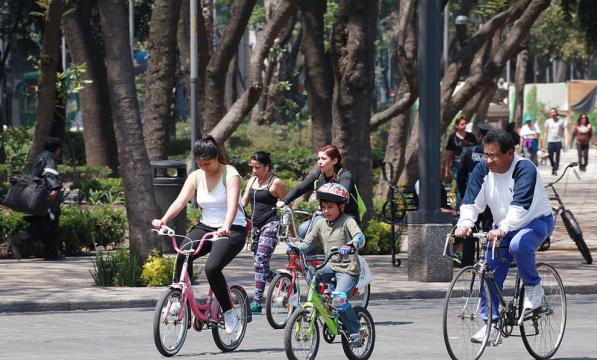Why should cyclists support Road Safety Week 2015?

Road Safety Week goes green
Monday is the start of the annual Road Safety Week coordinated by the road safety charity Brake. In the past, cycling organisations have perhaps given this lukewarm support, without really fully committing to their campaign. So, is that the right approach as Brake announce that Road Safety Week is going green with the theme of drive less, live more?
In discussing road safety for cyclists we often talk about important issues concerning road justice, traffic law enforcement, lorry design and space for cycling. In doing so it is easy to forget the obvious, that road safety is about getting around in a way that causes no harm to yourself and others. Brake's 2015 message is that a big part of that is driving less.
The safest mile is the mile not driven
From a cycling perspective we might take 'the safest mile is the mile not driven' one revolution further with a 'cycle a mile for safety' message. A cycled mile does not automatically equate to one mile less driven, but replacing car use where possible and reducing the number of vehicles on the roads is a Road Safety Week target, which we must surely support.
For obvious reasons we raise our concerns regarding road safety statistics concerning injuries and worse to cyclists. The anomaly is that the UK has one of the best road safety records in Europe per mile travelled. The problem is that the same is not true for cyclists and pedestrians, however if we walked and cycled as much as people in Sweden or the Netherlands academics suggest we would fall down the safety rankings for those vulnerable road users significantly.
Put simply the UK road safety record is skewed because so few people walk and cycle compared to many other European countries, with surveys showing that it is the perceived danger from traffic which is one of the main factors preventing families and commuters from cycling.
Safety in numbers
CTC have campaigned previously on the safety in numbers argument, and highlighted the evidence that cycling gets safer the more people do it. It's not a new idea but something which seems to have slipped down the road safety agenda recently. Brake's decision to highlight 'drive less, live more' as this year's Road Safety Week theme, linking road safety with sustainability and health issues, is a timely reminder that road safety is not a stand alone issue but is inextricably linked with encouraging cycling.
The campaigner's hat
If you attend any cycling conference or speak with campaigners it is not difficult to identify the campaign hat of preference for many of the participants. My job title as road safety and legal campaigns officer obviously gives a clue as to mine. There is then the 'infrastructure hat', often worn by those who argue that re-designing our roads' infrastructure and creating space for cycling will solve all ills, sometimes neglecting the fact that we will still have some drivers who will just ignore the rules whatever, and that enforcement will remain an important issue.
There are also hybrid hats worn by those who believe education and behavioural change is the answer, those whose antagonism to all motorists does not assist what should be the common aim, others who seek to distinguish 'normal everyday cyclists' from 'MAMIL's', and those who might represent or support them. Sometimes we can appear a disparate group of protesters.
The common aim
What is this or what should it be? It should be the encouragement of cycling as a normal everyday activity for everyone, which means being inclusive of all cyclists however broadly defined, and exclusive of none.
To encourage cycling we need to make sure that it is a safe activity, and crucially that people perceive it to be safe. Brake's argument within this year's Road Safety Week is beautifully simple - encouraging other forms of transport such as cycling will reduce the number of cars on the road, reduce risk and perception of risk, encourage more cycling, reduce car use even more.
This is the safety in numbers argument from a different perspective, not a new idea, but something we seem to have stopped saying.
Being self-critical my role involves me highlighting road justice issues as part of a road safety message. There is a risk that this leads to reports, news and blogs sounding too bleak and depressing, when the common aim is to encourage more cycling. Memo to self - try and be positive about road safety!
Encouraging cycling as part of road safety
We cannot ignore enforcement and road justice issues, just as we cannot ignore infrastructure, space for cycling and the encouragement of cycling participation. We sometimes fail to see the wood for the trees however when we put our individual hats on and concentrate on one issue, rather than the common aim.
If Brake's 2015 theme the Road Safety Week does nothing else, it should remind us that encouraging cycling and road safety are two sides of the same coin, and that cycle campaigning needs to incorporate both.
Don't overlook Brake's Road Safety Week. There is not much to disagree with. If the mainstream road safety campaigns are moving towards us we need to embrace this wholeheartedly.

